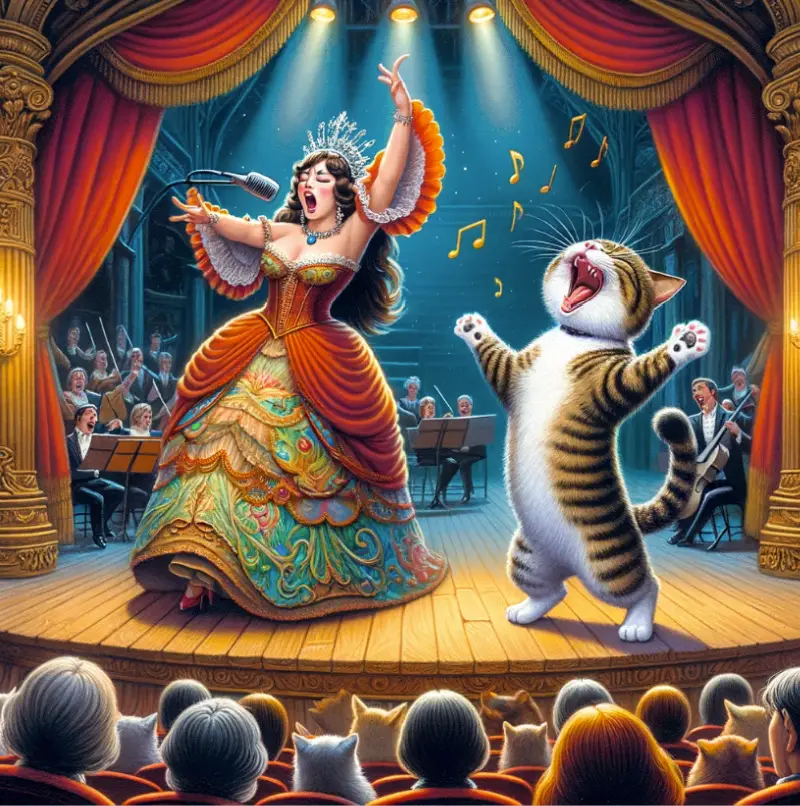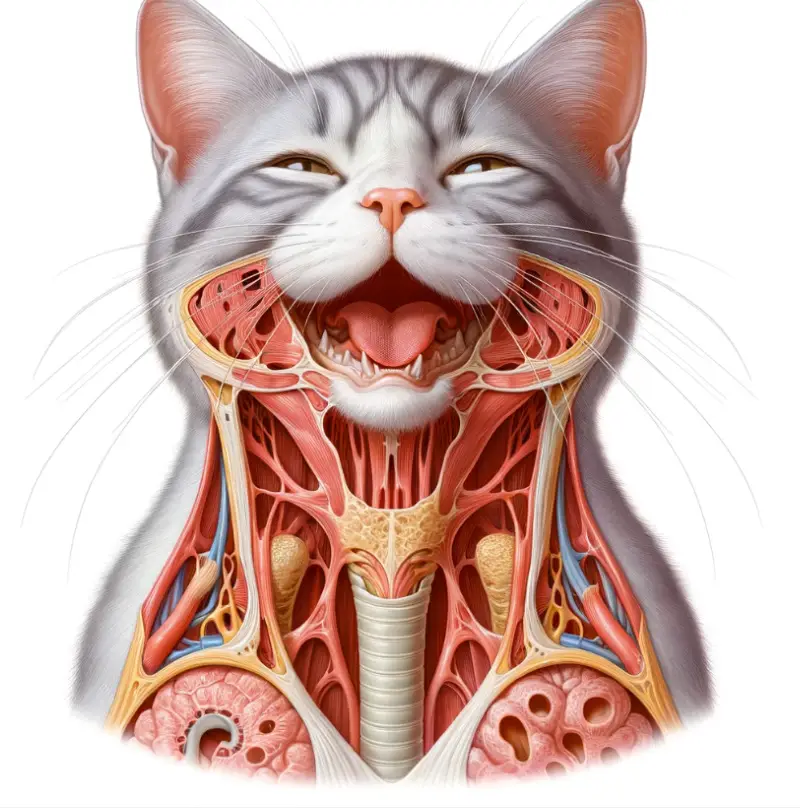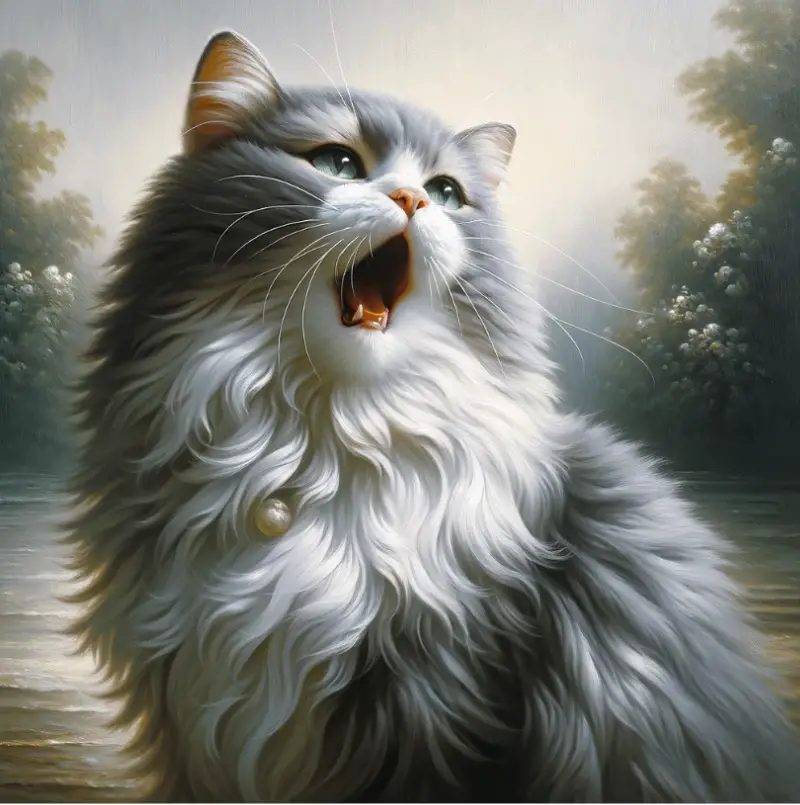
Cats, those mysterious and captivating creatures, have a rich repertoire of vocalizations that they use to communicate with humans and each other. Among these sounds, cat trilling stands out as a unique and charming form of expression.
The word “trilling” has its roots in Old English. It derives from the Middle English word “trillen,” which means to vibrate or quiver. In modern usage, “trilling” often refers to a musical technique where a rapid alternation between two adjacent notes is performed, creating a fluttering or vibrating sound, particularly in vocal or wind instrument performance. It also refers to the sound produced by certain animals (cats, birds, rodents, reptiles, dolphins & insects).
Imagine trilling like an opera for cats – where whiskers meet Wagner and purrs harmonize with Puccini in a symphony of theatrical delights.

Let’s delve into the fascinating world of cat trilling, exploring why cats trill, how they produce this melodic sound, and when they use it in various social contexts. By understanding the nuances of cat trilling, cat owners can deepen their bond with their feline companions and enhance their communication with these enigmatic creatures.
Why Do Cats Trill?
Cat trilling serves several purposes in feline communication, reflecting a range of emotions and intentions. Understanding why cats trill can provide valuable insights into their behavior and help cat owners respond appropriately to their needs.

Here are some common reasons why cats trill:
1. Affection and Greeting: One of the primary reasons cats trill is to express affection and greet their owners or other cats. When a cat trills upon seeing you, it’s their way of saying hello and showing that they’re happy to see you. This friendly vocalization is often accompanied by purring and rubbing against your legs, reinforcing the cat’s desire for interaction and attention.
2. Request for Attention: Cats may trill as a way of seeking attention or initiating interaction with their owners. If your cat trills while looking at you or approaching you, they may be signaling that they want to play, cuddle, or simply spend time with you. Responding positively to your cat’s trills by engaging in interactive play or offering affectionate gestures can strengthen the bond between you and your furry friend.
3. Communication Between Cats: Trilling is also used as a form of communication between cats, particularly in multi-cat households or social groups. Cats may trill to one another as a sign of friendship, familiarity, or to initiate play. This melodic vocalization helps strengthen social bonds among cats and fosters a sense of harmony within the group.
4. Expressing Happiness or Contentment: Cats may trill when they’re feeling happy, content, or relaxed. This gentle vocalization reflects a positive emotional state and can occur in various situations, such as when a cat is lounging in a sunny spot, enjoying a meal, or receiving affection from their owner. Trilling in these contexts serves as a vocal expression of the cat’s well-being and satisfaction.
How Do Cats Trill?
The distinctive sound of cat trilling is produced through a combination of vocalization and mouth movements. While the exact mechanism behind cat trilling isn’t fully understood, it’s believed to involve the coordination of the vocal cords, tongue, and mouth muscles.

Here’s a simplified explanation of how cats trill:
1. Vocalization: Like other feline vocalizations, cat trilling begins with the vibration of the cat’s vocal cords. Cats have a specialized larynx (voice box) that allows them to produce a wide range of sounds, from meows and purrs to chirps and trills. The vocal cords generate the initial sound of the trill.
2. Mouth Movements: In addition to vocalization, cats also use their mouth and tongue to modulate the sound of the trill. During a trill, a cat may open and close their mouth rapidly, creating a rolling or undulating effect in the sound. The tongue may move in a fluttering motion, further enhancing the melodic quality of the trill.
3. Breath Control: Cats also regulate their breath while trilling, controlling the airflow through their vocal apparatus to produce the desired sound. This breath control helps modulate the pitch and intensity of the trill, allowing cats to convey different emotions and intentions through their vocalizations.
When Do Cats Trill?
Cat trilling can occur in various social contexts and situations, each serving a specific purpose in feline communication. Understanding when cats trill can provide valuable insights into their behavior and emotional state.

Here are 5 common scenarios in which cats trill:
1. Greeting: Cats often trill when they greet their owners or other cats. Whether it’s a friendly hello when you come home from work or a warm welcome to a feline friend, trilling serves as a social lubricant, signaling friendliness and openness to interaction.
2. Affection: Cats may trill as a way of expressing affection towards their owners or other cats. Trilling during cuddle sessions or while receiving pets and scratches is a cat’s way of saying “I love you” and enjoying the bonding experience with their human or feline companion.
3. Request for Attention: When cats want attention or interaction, they may trill to get their owner’s or another cat’s attention. Trilling while looking directly at you or approaching you is often a clear signal that your cat wants to engage in play, receive affection, or simply spend time with you.
4. Playtime: Trilling is commonly associated with play behavior in cats. When cats are in a playful mood, they may trill as they chase after toys, engage in mock battles with other cats, or participate in interactive games with their owners. Trilling during play serves as a way for cats to communicate their enthusiasm and enjoyment of the activity.
5. Comfort and Contentment: Cats may trill when they’re feeling happy, relaxed, or content. Trilling while lounging in a sunny spot, enjoying a cozy nap, or snuggled up with their favorite human or feline companion is a cat’s way of expressing their satisfaction and well-being.

Whether it’s a greeting, an expression of affection, or a request for attention, trilling plays a significant role in cats’ social interactions with humans and other cats. By understanding the why, how, and when of cat trilling, cat owners can deepen their bond with their feline companions and enhance their communication with these beloved pets.
Summary
Cat trilling is a fascinating and multifaceted form of feline communication that reflects a range of emotions and intentions. So, the next time your cat graces you with a melodious trill, take a moment to appreciate the unique language of feline communication and cherish the special connection you share with your furry friend.



